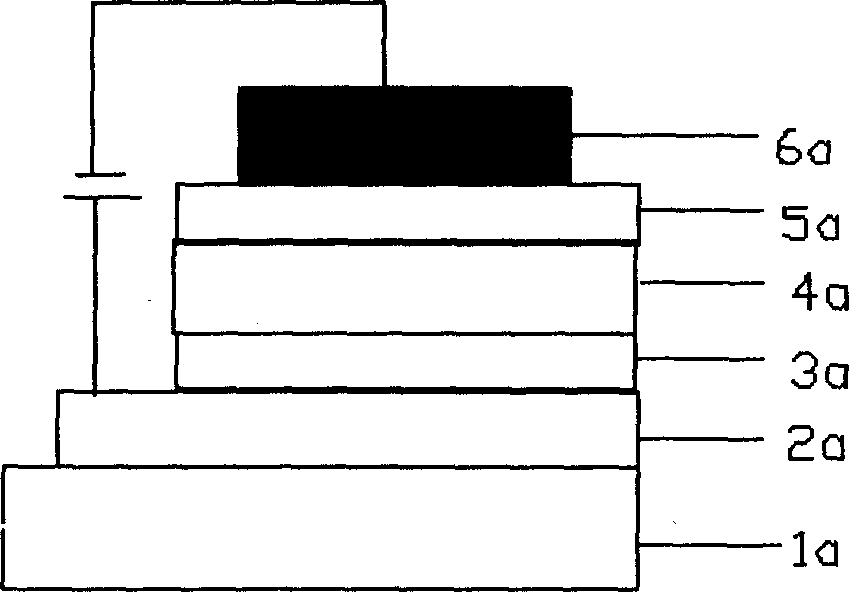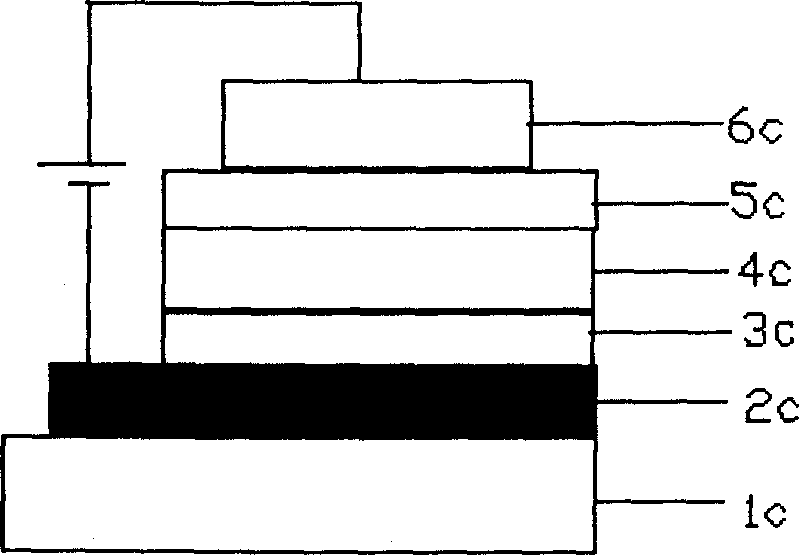Organic / macromolecule top emission light-emitting device and its application
A light-emitting device and top-emission technology, which is applied in the direction of organic semiconductor devices, semiconductor/solid-state device manufacturing, and luminescent materials, can solve the problems of complex manufacturing process and easy damage to the light-emitting layer, and achieve simple manufacturing process, good environmental stability, The effect of high quantum efficiency
- Summary
- Abstract
- Description
- Claims
- Application Information
AI Technical Summary
Problems solved by technology
Method used
Image
Examples
Embodiment 1
[0062] ITO conductive glass, sheet resistance ~ 20Ω / □, or ordinary glass without ITO, pre-cut into 15mm×15mm square pieces. Sequentially use acetone, special detergent for micron semiconductors, deionized water, and isopropanol to ultrasonically clean, nitrogen purged, then placed in a constant temperature oven for standby, and further processed in an oxygen plasma cleaner before use.
[0063] After weighing the fluorescent conjugated polymer in a clean bottle, transfer it to a nitrogen-protected film-forming glove box (VAC company), dissolve it in toluene, and filter it with a 0.45 micron filter membrane. The optimal thickness of the polymer light-emitting layer is 70-90 nanometers. The film thickness was measured with a TENCOR ALFA-STEP-500 surface profiler. PFNBr-BTDZ05, PFN-BTDZ05, PF-N + R 3 , PF-NR 2 Dissolve them in methanol respectively, and prepare three solutions with concentrations of 0.02%, 0.1%, and 0.2%. Use the uniformly glue machine to rotate the pre -stea...
Embodiment 2
[0082] Repeat Example 1, but the polymer light-emitting layer is replaced by green light-emitting phenyl-substituted poly-p-phenylene vinylene (P-PPV), and the electron injection layer uses PFNBr-BTDZ05 or neutral precursor PFN-BTDZ05 respectively. The experimental results are summarized in Table 6 and Table 7, respectively.
[0083] Table 6 is based on the green light material P-PPV, using aluminum as the cathode, using gold as the transparent anode, and using
[0084] Emissive
Thickness
()
A node
(V)
Current
(mA)
Luminance
(cd / m2)
QE
(%)
P-PPV
P-PPV
P-PPV
50
100
200
Al
Al
Al
Au
Au
Au
24.2
26.5
30
12.6
29.1
3.61
155
2738
128
0.16
1.2
0.45
[0085]The top-emitting light-emitting device structure in Table 6 is ITO / Al / PFNBr-BTDZ05 / P-PPV...
Embodiment 3
[0093] Repeat Example 2. The polymer light-emitting layer was replaced by polyfluorene (PFO) that emits blue light, and poly[9,9-dioctylfluorene-9,9-bis(N,N-dimethylaminopropyl)fluorene] A three-component copolymer with a narrow band gap (narrow band gap monomer benzothiadiazole) (PFN-BTDZ05) was used as the electron injection layer. The experimental results are summarized in Table 8. Figure 9(a) is a graph of voltage-current-luminescence luminance of a top-emitting light-emitting device using PFN-BTDZ05 as the electron injection layer, blue-emitting polyfluorene (PFO), aluminum as the cathode, and gold as the transparent anode. Fig. 9(b) is the electroluminescence spectrum of the top emission light-emitting device.
[0094] Table 8 is based on the blue light material PFO, using aluminum as the cathode, using gold as the transparent anode, and using PFN-BTDZ05
[0095] Emissive
Thickness
()
A node
Voltag...
PUM
| Property | Measurement | Unit |
|---|---|---|
| thickness | aaaaa | aaaaa |
Abstract
Description
Claims
Application Information
 Login to View More
Login to View More - R&D
- Intellectual Property
- Life Sciences
- Materials
- Tech Scout
- Unparalleled Data Quality
- Higher Quality Content
- 60% Fewer Hallucinations
Browse by: Latest US Patents, China's latest patents, Technical Efficacy Thesaurus, Application Domain, Technology Topic, Popular Technical Reports.
© 2025 PatSnap. All rights reserved.Legal|Privacy policy|Modern Slavery Act Transparency Statement|Sitemap|About US| Contact US: help@patsnap.com



